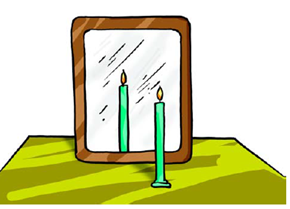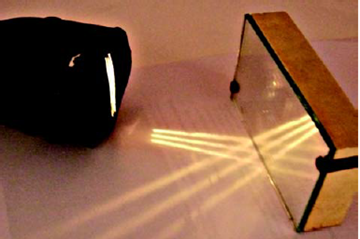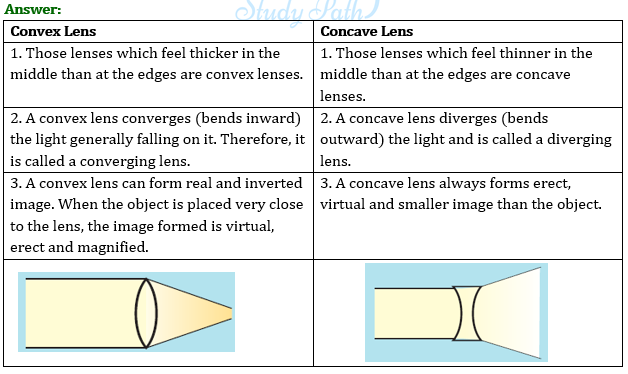Extra Questions for Class 7 Science Chapter 15 Light
Extra questions for Class 7 Science Chapter 15 Light with answers is given below. Our subject expert prepared these solutions as per the latest NCERT textbook. These questions will be helpful to revise the all topics and concepts. CBSE Class 7 extra questions are the most simple and conceptual questions that are prepared by subject experts for the students to study well for the final exams. By solving these extra questions, students can be very efficient in their exam preparations.
Light Class 7 Science Extra Questions and Answers
Very Short Extra Questions and Answers
1. What type of mirror is used as a side view mirror in a scooter?
Answer: Convex mirror.
2. How can we change the direction of the light?
Answer: We can change the direction of the light by phenomenon called reflection.
3. Which type of mirror can form a real image?
Answer: Concave mirror can form a real image.
4. Which type of lens forms always a virtual image?
Answer: Concave lens forms always a virtual image.
5. Give an example of a curved mirror.
Answer: The most common example of a curved mirror is a spherical mirror.
6. What are the two types of spherical mirror?
Answer: The two types of spherical mirror are concave and convex mirrors.
7. What is real image?
Answer: An image which can be obtained on a screen is called a real image.
8. Write some uses of lenses.
Answer: Lenses are widely used in spectacles, telescopes and microscopes.
9. What is convex mirror?
Answer: If the reflecting surface is convex, then it is a convex mirror.
10. What happens when light falls on a polished or a shiny surface?
Answer: When light falls on a polished or a shiny surface light gets reflected.
11. What makes things visible to us?
Answer: Objects are visible only when light reflected from them reaches our eyes.
12. What is diverging lens?
Answer: A concave lens diverges (bends outward) the light and is called a diverging lens.
13. What kind of image is formed by concave lens?
Answer: A concave lens always forms erect, virtual and smaller image than the object.
14. What is the nature of the image formed by a convex mirror?
Answer: Image formed by a convex mirror is erect, virtual and smaller in size than the object.
15. What is reflection of light?
Answer: Bouncing back of a light ray after hitting any surface is known as reflection of light.
16. What is concave mirror?
Answer: If the reflecting surface of a spherical mirror is concave, it is called a concave mirror.
17. Why we are not able to see the candle flame through a bent pipe?
Answer: We are not able to see the candle flame through a bent pipe because light travels along straight lines.
18. How can we change the path of light?
Answer: We can change the path of light by keeping any shiny or polished or reflecting material in front of the light beam.
19. What type of image does the outer side of a spoon show?
Answer: The outer surface of a spoon acts like a convex mirror. Image formed by a convex mirror is erect, virtual and smaller in size than the object.
20. What happens when light falls on a mirror?
Answer: A mirror changes the direction of light that falls on it. This change of direction by a mirror is called reflection of light.
Short Extra Questions and Answers
1. When does rainbow appear in the sky?
Answer: Rainbow appears usually after the rain when the sun is low in the sky. The rainbow is seen as a large arc in the sky with many colours.
2. We see reflection of trees or buildings in water. Give reason.
Answer: The surface of water can also act like a mirror and change the path of light. Thus, we see reflection of trees or buildings in water.
3. Why are concave and convex mirrors called spherical mirrors?
Answer: Concave and convex mirrors are called spherical mirror because their reflecting surfaces are the parts of hollow sphere of glass.
4. Give one use each of a concave and a convex mirror.
Answer: Concave mirrors are used by dentists to see an enlarged image of the teeth. Convex mirrors are used as side mirrors in vehicles.
5. Why the image formed is erect and is of the same size in stainless steel plate?
Answer: The image formed is erect and is of the same size in stainless steel plate because it acts as a plane mirror.
6. What kind of image is formed by convex lens?
Answer: A convex lens can form real and inverted image. When the object is placed very close to the lens, the image formed is virtual, erect and magnified.
7. Write the uses of convex mirror.
Answer: Uses of convex mirror are:
- They are used as side mirrors in vehicles.
- They are used in magnifying glass.
8. Do you see colours similar to those in a rainbow somewhere else?
Answer: Yes, when we blow soap bubbles, they appear colourful. Similarly, when light is reflected from the surface of a Compact Disk (CD), we see many colours.
9. Tina has prepared a small top with a small circular disc with seven rainbow colours painted on it. When the top rotates it appears nearly white. Why?
Answer: When the top is rotated fast, the colours get mixed together and the top appears to be whitish.
10. What is the nature of the image formed by a concave mirror?
Answer: A concave mirror can form a real and inverted image. When the object is placed very close to the mirror, the image formed is virtual, erect and magnified.
11. What type of image does the inner side of a spoon show?
Answer: The inner surface of a spoon acts like a concave mirror. Image is erect and larger in size. If we increase the distance of the spoon from our face, we may see our image inverted.
12. State the characteristics of the image formed by a plane mirror.
Answer: The image formed by a plane mirror is erect. It is virtual and is of the same size as the object. The image is at the same distance behind the mirror as the object is in front of it.
13. What is a virtual image? Give one situation where a virtual image is formed.
Answer: An image which cannot be obtained on a screen is called a virtual image. The image formed by a plane mirror is virtual image because it could not be obtained on a screen.
14. How many colors is white light composed of?
Answer: Sunlight consists of seven colours. The sunlight is said to be white light. This means that the white light consists of seven colours. These are red, orange, yellow, green, blue, indigo and violet.
15. Why does obtaining the image of the sun on a paper with the help of a concave mirror burn the paper?
Answer: Obtaining the image of the sun on a paper with the help of a concave mirror burn the paper because concave mirror converge the sunrays to one point.
Long Extra Questions and Answers
1. Write the uses of concave mirror.
Answer: Concave mirrors are used for many purposes. Doctors use concave mirrors for examining eyes, ears, nose and throat. Concave mirrors are also used by dentists to see an enlarged image of the teeth. The reflectors of torches, headlights of cars and scooters are concave in shape.
2. How can you show the image of the sun on a paper?
Answer: Take a concave mirror. Hold it facing the sun. Try to get the light reflected by the mirror on a sheet of paper. Adjust the distance of the paper until you get a sharp bright spot on it. This bright spot is, in fact, the image of the sun.
3. The rear view mirror of a car is a plane mirror. A driver is reversing his car at a speed of 2 m/s. The driver sees in his rear view mirror the image of a truck parked behind his car. The speed at which the image of the truck appears to approach the driver will be _________.
Answer: The image of the truck will travel a distance twice the distance travelled by the car in equal time. Therefore, image of the truck will appear to approach the driver with the speed of (2 + 2) m/s i.e., 4 m/s.
4. Write an experiment to show that the sunlight consists of seven colours.
Answer: Take a glass prism. Allow a narrow beam of sunlight through a small hole in the window of a dark room to fall on one face of the prism. Let the light coming out of the other face of the prism fall on a white sheet of paper or on a white wall. We see colours similar to those in a rainbow. This shows that the sunlight consists of seven colours.
5. Why the word ambulance is written laterally inverted on ambulance vehicle?
Answer: The word ambulance is written laterally inverted on ambulance vehicle because when the driver of a vehicle ahead of an ambulance looks in her/his rear view mirror, she/he can read “AMBULANCE” written on it and give way to it. It is the duty of every one of us to allow an ambulance to pass without blocking its way.
6. Find out the letters of English alphabet or any other language known to you in which the image formed in a plane mirror appears exactly like the letter itself. Discuss your findings.
Answer: Image of letters of English alphabet such as A, H, I, M, O, T, U, V, W, X, Y formed in a plane mirror appears exactly like the letter itself. Vertical symmetry is found in the letters A, H, I, M, O, T, U, V, W, X and Y. This means that the right side is a reflection of the left.
7. What is the difference between an object and an image?
Answer: Place a lighted candle in front of a plane mirror. Try to see the flame of the candle in the mirror. It appears as if a similar candle is placed behind the mirror. The candle, which appears behind the mirror, is the image of the candle formed by the mirror. The candle itself is the object.

8. David is observing his image in a plane mirror. The distance between the mirror and his image is 4 m. If he moves 1 m towards the mirror, then find out the distance between David and his image.
Answer: Distance between the mirror and David’s image is 4m.
If the David moves 1 m towards the mirror, then the distance between mirror and David’s image will be (4 – 1) m = 3m
We know that in case of plane mirror image is at the same distance behind the mirror as the object is in front of it. Therefore,
Distance between David and mirror = Distance between mirror and David’s image
So, Distance between David and his image = Distance between David and mirror + Distance between mirror and David’s image (i.e., 3 + 3 = 6 m)
9. Show that the image is at the same distance behind the plane mirror as the object is in front of it.
Answer: Take a chess board. Draw a thick line in the middle of it. Fix a plane mirror vertically on this line. Place a pencil sharpner, at the boundary of the third square counting from the mirror. Note the position of the image. Now shift the object to the boundary of the fourth square. Again note the position of the image. We will find that the image is at the same distance behind the mirror as the object is in front of it.

10. Show how light gets reflected from a plane mirror with the help of an activity.
Answer: Take a torch. Cover its glass with a chart paper which has three slits. Spread a sheet of chart paper on a smooth wooden board. Fix a plane mirror strip vertically on the chart paper. Now direct the beam of light on the mirror from the torch with slits. Place the torch in such a way that its light is seen along the chart paper on the board. Now adjust its position so that the light from the torch strikes the plane mirror at an angle. We will see that the mirror change the direction of light that falls on it. Now move the torch slightly to either side. We will see change in the direction of reflected light too. Look into the mirror along the direction of the reflected light. We see the slits in the mirror. This is the image of the slits. This activity shows how light gets reflected from a plane mirror.

11. State the differences between a convex and a concave lens.
Answer:
